Grading IRONMAN’s 70.3 Worlds Broadcast
The 2024 IRONMAN season has finally come to a close. And with it, so does the broadcasting of IRONMAN Pro Series events. The 20 events produced over 150 hours of live content, and streamed on a variety of platforms. For U.S. and Canada, that was on Outside Watch; for the rest of the world, it was on DAZN or YouTube.
For this article, we’re looking solely at the viewing experience from this weekend’s IRONMAN 70.3 Worlds coverage broadcast on the Outside Watch platform. Although I could have easily VPN’d myself into a YouTube coverage experience, I wanted to be able to review it as IRONMAN intended the experience for American and Canadian audiences.
Race Action Coverage: B
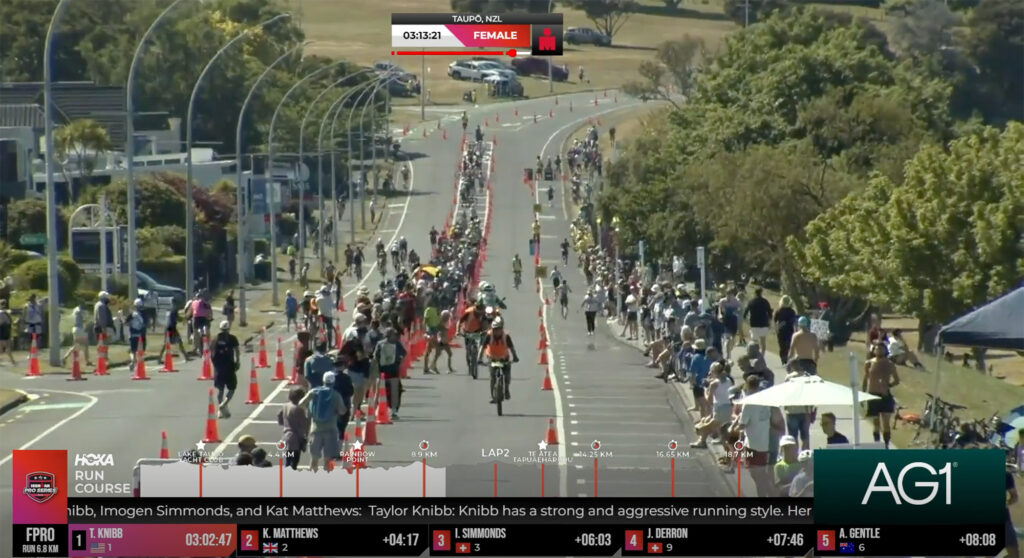
For the most part, across both days, the critical moves on course were captured. On Saturday alone we got to see, for instance, Taylor Knibb rocket her way past Sara Perez Sala and never give that lead up again. We were with Kat Matthews as she made her critical bridge up to Imogen Simmonds and Paula Findlay. And we saw the gap get agonizingly tight between Knibb and Matthews on the second lap of the run.
On the men’s side, we had a healthy back and forth between the leading group of 8 men and the 9 man deep chase group. We also got to see the pack dynamics within those two groups, as the likes of Lèo Bergère, Hayden Wilde, and Rico Bogen traded places back and forth throughout the lead pack, whereas Kristian Høgenhaug repeatedly tried to break the chase apart. And, of course, we watched Wilde’s lead evaporate in the span of two kilometers as Jelle Geens wrested the title from his hands.
We also saw a fair amount of “the race within the race” battles for positions within the IRONMAN Pro Series. It helped, of course, that Matthews was right at the front of the women’s field, but we also saw Matthew Marquardt’s struggles on the bike and run as he came up short in his bid to take the Series crown. On the flip side, Gregory Barnaby’s run and finish were missed completely. It also was somewhat surprising to not have him included in the immediate post-race interviews, having won the Series.
Camera Work: C-
I am admittedly sensitive to camera jostling and shaky images, thanks to my concussion history and mild visual processing issues. So when, during the broadcast Sunday, the camera feed swapped to chasing Høgenhaug as he looked to establish himself with the chase group on a downhill, I started feeling sick to my stomach. Høgenhaug was, at best, half in frame, and with the image bouncing everywhere.
It, unfortunately, was not much better on the run segment for the men. Even the critical pass for the race featured a fair amount of bounce.
The women’s race was not as bad. Whether that was due to the bike pace being slower, or if there were different camera operators in place each day, it made it slightly better. But clearly there was an issue of either equipment or operator given the conditions that were faced on the day. I was very glad to be done watching at the end.
Studio Broadcasters: B-
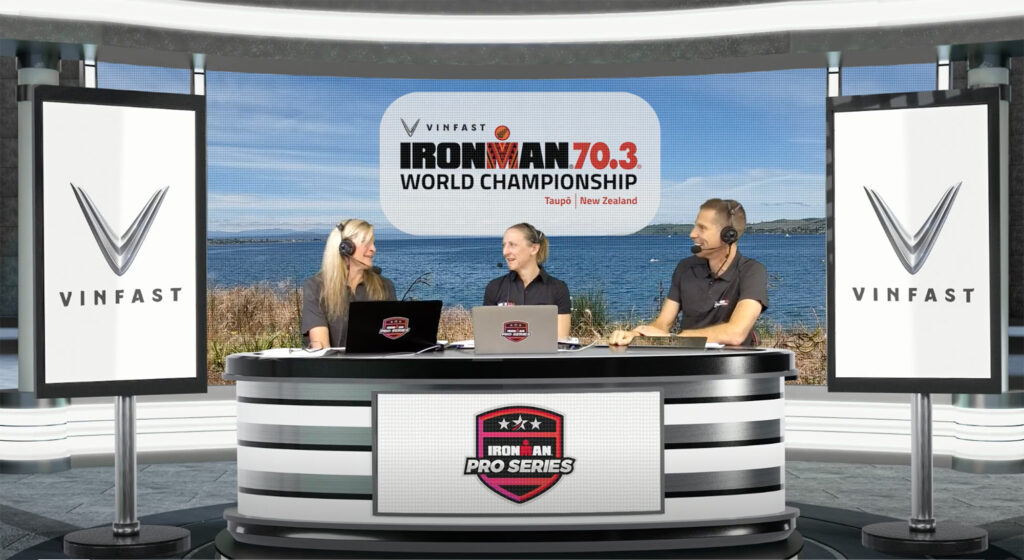
Michael Lovato and Dede Griesbauer have a thankless job. Being able to talk for hours on end, with what amounts to the same talking points, and make it at least mildly entertaining is extremely hard. There are precious few traditional broadcasters who are able to pull this off.
Lovato and Griesbauer have good chemistry with one another, and their passion for the sport comes through, which on the whole makes their broadcasting palatable. However, there are two areas with plenty of room for improvement. First is on athlete identification; both misidentified athletes on camera multiple times, but particularly during the men’s race. That would be more forgivable if more information about what was happening off-camera was being relayed to the pair and able to tell that story effectively.
For example: it was not until after the race that we heard of any bike penalties beyond the one to then-leader Mathis Margirier, and we only knew of that because we saw him pull into a penalty tent. More often than not, the duo are being forced to rely on what’s coming in via the tracker versus getting any information from spotters on the ground. That means when you have situations where timing boxes aren’t relaying information — like they failed during the women’s race on the bike — they, and us the audience, are left to wonder what is happening on course.
On Course Broadcasters: B+

Craig Alexander, Mirinda Carfrae, Matt Lieto, and Greg Welch combined to give great detail and analysis throughout their hours on-screen. In particular, Carfrae has proven herself to be an excellent addition to any broadcast she’s on. She is knowledgeable, insightful, entertaining, and versatile; she’s able to go from reporter to interviewer to host relatively seamlessly. Lieto, too, does a good job in his role heading out on course, whether on the back of a motorcycle or at a specific point during the run.
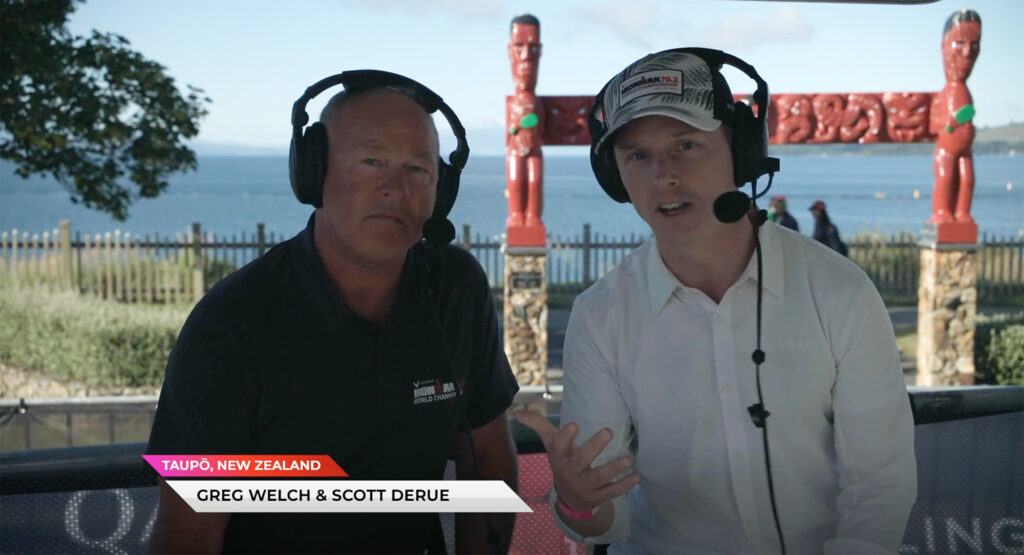
The primary letdown? Technical issues out on the bike course when Lieto was attempting to relay information.
On-Screen Graphics: C
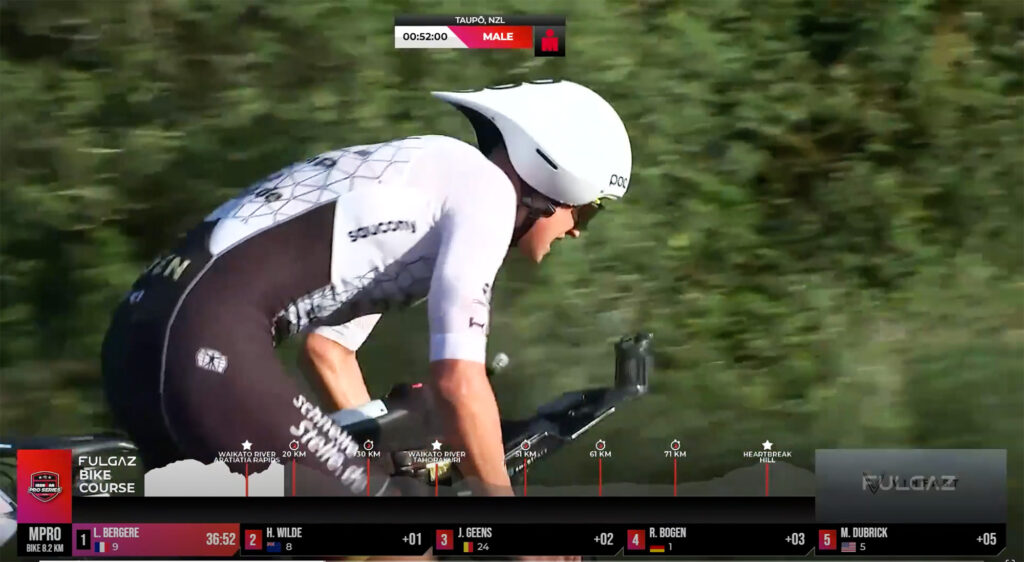
Can we all please just admit that trying to use AI to write race predictions, based on old timing split data, is a terrible idea? It was at its worst as Wilde’s lead was evaporating, as the AI predictor was still trying to say that Wilde would win and run a time that he clearly was no longer capable of.
Perhaps the most useful graphic on screen was the topographic map to show where the lead of the race was. However, the placement of it in the bottom-third, which was cluttered with AI text and other items, versus in some of the empty space at the top, hindered the intended effect.
And, much like with other race formats, it only focused on the head of the race; it never gave splits back through the field, so unless you had your IRONMAN app on the entire time, you’d have never known what was happening for non-podium places until athletes crossed the finish line.
Commercials: B-
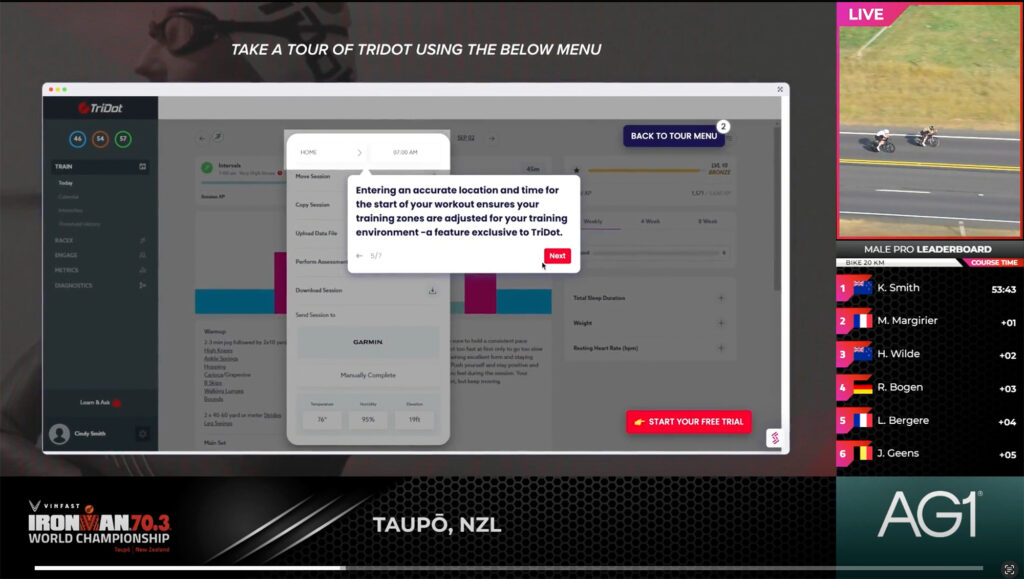
I am not counting any of the infomercial / in-broadcast advertising; this is just in reference to the actual ad units that the broadcast would cut to.
It’s very easy to hate on the advertising during an IRONMAN broadcast. You’re pretty much guaranteed to see ads for Qatar Airways, HOKA, Wahoo, Maurten, Breitling, Vinfast, etc. on a countless loop. And the ad breaks themselves often have impeccable timing; for example, starting the women’s coverage, there was an ad break less than three minutes into the broadcast. Coming right off of the back of the ad unit that had to be watched in order to access the broadcast, it can leave a sour taste in your mouth.
That said, I wound up counting up and timing the broadcast breaks on Saturday. There were 20 total commercial breaks during Saturday’s race, which constituted roughly 11% of the total broadcast time. For comparison’s sake, in your average NFL three hour game broadcast, a full 25% of the broadcast is commercials.
In other words: it’s really not as bad as it seems, at least from a time perspective. But better ad break coordination (especially, say, not missing the finish of your Pro Series champion on the live stream) would improve the experience greatly.
Platform Stability: A-
For as poor of a platform Outside Watch was during the original go-round of IRONMAN broadcasts, it has come an awful long way. There was only one moment towards the end of the bike during the men’s race where I suffered a moment of buffering. Otherwise, the platform was about as bulletproof as it possibly could be.
Overall Grade: B-
IRONMAN produced another decent triathlon livestream broadcast. It’s free for us to watch. We saw the major moments of the race, and it didn’t glitch. Although there’s definitely room for improvement, it scratches the itch for most of triathlon’s existing audience.
Tags:
IRONMAN 70.3 World ChampionshipsIRONMAN Pro SeriesOpinionContinue the discussion at forum.slowtwitch.com
37 more replies




You forgot to mention that during a lot of the mens race, they were mis naming all kinds of athletes and running with that misinformation for long periods of time. I mean we had a good discussion going on the forum in real time, we all recognized who was who, but for some reason they could not.
This is a very simple thing too, as each athlete has a # and a name associated with it. They have a master list, so if they dont recognize someone, just look it up. I think They called Leo several different athletes before finally getting it right. And it always feels like they dont figure it out, but someone is texting them in all CAPS that in fact they are calling the wrong folks who are on screen…
And yes that graphic at the bottom is useless and annoying. Just would be nice to have a list of who is where and time differences. Do that and the rest would be gravy…
One thing that I’ve never understood is why the broadcasters (whether IM or T100) insist on using only splits from the most recent timing mat and then clear the board once the lead athlete crosses a new mat.
Just have a running list of who’s in what position, and then when they cross any timing mat, update that person’s time and position.
It’s annoying on the men’s side, but often gets worse on the women’s side when someone like Knibb has a 6 min lead and is a whole timing mat away from everyone else.
Outside+ is a joke, poor quality, no ability to rewind, zero production skills in terms of ad timing. Broadcast streaming is literally their main business and the user experience is abysmal. I do not understand why Ironman would negatively affect their own brand with such a lame partnership, when YouTube is so much better.
As for the commentators, I find them ok, except for the fact that they talk over each other all the time. I mean you have 4 hours of speaking ahead of you, there’s no rush!
Solid points
Easy… Outside helps pay the bills… Youtube doesn’t…
I am happy to get what I pay for.
You have such a good heart Ryan!
I don’t think I found the other issue being named explicitly in the article, the first being misidentifying the athletes? Is it not knowing what’s going on on the course?
It’s a good contrarian opinion piece. Not an expert, but opinion pieces are for opinions. And camera shaking being the biggest problem with the coverage - during which commentators were unable to talk about the athletes’ recent history - is, well, an opinion
Boring, predictable and no where near as good as T100 coverage.
At one point they had 3 athletes in 7th place, one was 45 ish seconds behind and the 3rd one was 6 mins ish back. Later on you couldn’t tell who was anywhere except the top 5/6. No information on pace, who was closing etc.
Time to bring in a new team. Welch is terrible, the guy with the tache looks like a corn star and Carfrae saved the day.
One more thing.
Lovato
Griesbauer
Welsh
Lieto
Rinny
Crowie
Siddall (on Saturday)
Who did I miss?
And the race is 3.5 hours minus the ads minus the sponsor and other features minus the athlete interviews and everything else.
(Also I do think people have a responsibility not to take on tasks they know they will be terrible at).
From a European perspective:
Race Action Coverage: C
You can’t score any higher when you miss arguably the key moment in the men’s race because of a pre-ordained studio interview. One minute we were hearing about the women’s race, the next we had commentators scrabbling around to tell us that Geens was about to catch Wilde. Not good.
Camera Work: B
The aerial shots were nice & the run course coverage was excellent. Especially considering on lap 2 the camera operators had to contend with AG athletes on course.
I think we can chalk the shaky bike images up to poor road surface. We either get shake close ups or just watch a helicopter shot all day
Studio Broadcasters: B-
Why in god’s name did we not have Laura Siddall both days? At least she knows what she’s talking about. It’s one thing to be enthusiastic, it’s entirely another to be knowledgable and good commentators.
T100 coverage and WTCS does a better job of employing professional commentators whose main job is to describe sports and have had to “learn” triathlon. Versus taking triathletes and trying to get them to describe sports.
On Course Broadcasters: B+
Largely agree but the biggest miss was lack of information when trying to describe what was going on. It said it all that Rinnie was having to read the IM tracker app off her phone…
On-Screen Graphics: C
We need live time splits. Until we get this, all on-screen graphics are irrelevant. If the race is at all dynamic, the time split from 15k ago on the bike is pointless. Don’t get me started on the AI either…
Commercials: E
Comparing it to an NFL game is fine. Now try a European football game, rugby game or anything else covered here. No adverts during live action, save it for half time. I appreciate there isn’t a half time equivalent during triathlon but just look at how the T100 play it on Discovery+. This alone made the broadcast basically unwatchable for me.
Platform Stability: A
I didn’t suffer any issues on the YouTube stream.
Overall Grade: C
Borderline unwatchable & I only stuck with it in the background because I have a very strong interest in watching triathlon. This broadcast would have had zero appeal to a non-triathlete.
Surely as a sponsor (Vinfast etc.) you’d rather take the “less is more” approach to advertising? Instead of driving 90% of your potential audience away, leaving 10% to watch 3x the ads, why not grow the total audience & have fewer ads? You’re still getting more eyes on your product that way…
How much revenue does outside create ?
And what would be the cost per viewer for no adds and 50 percent less adds ?
For me, the T100 Broadcasts have it as well as you can expect at the moment.
Presenter on the ground (not a triathlon person) who is talking to members of the athletes teams or other pro’s that are there to watch (advantage of having contracted athletes I guess)
Commentators that make the exciting parts of the races sound exciting - Love him or hate him Jack Kelly does a good job with this and having Jan Frodeno or someone else alongside him helps. Triathlon is a long event where sometimes not a lot happens - it is inexcusable to not catch the most important parts like they did on Saturday
Knowing who the athletes are, from 1 to 20 at least. Ok we may not be able to see their numbers on the bike, but do the homework on what kits/bikes people are racing with. Everyone on this forum I bet could spot who an athlete was from a side view - if not the first time round then definitely second time.
However, maybe Ironman just aren’t overly interested in making this happen to a very high level? Their focus is on events, they get bigger crowds on the ground than the T100 do and their age group participation is bigger. When/if T100 match that as well as maintaining the TV coverage, then I think they may have a problem.
Correct – it’s that they’re not being fed enough information on course to tell us what’s happening off screen (e.g., the timing box going down on Saturday during the women’s bike, so you didn’t know just how much Knibb was pouring on the gas until the top of the climb; not knowing what was going on with the Wilde/Geens battle until it was nearly upon us).
They all made mention of T100 race locations. They didn’t say T100 by name. Same thing when they mention Roth. You, me, and just about everyone else watching the broadcast knows what they mean.
Visuals are everything when it comes to these events. I’m old enough to remember the entirety of live coverage being text updates from spotters on course and timing splits and MAYBE a finish line or transition camera.
For me (why are you surprised) very much this.
The women’s 71km mat failing was unfortunate because that would have pointed up Knibb’s push v Simmonds/Matthews (and indeed the chase pack). But in their shoes getting those splits from a moto ‘urgently’, once one realised the mat had failed is/was a stretch target. One of the 31k, 41k or 51k mats would not have mattered, but Knibb strategically pushed into the head wind and the long hill rightly judging that she could gain time there. But as she said completely blind: she got no splits to inform her in that section: the handicap of leading.
As for the Wilde-Geens battle, all it needed was a capable individual with the tracker in hand to see that the gap had stopped going out, had stabilised and then was coming in. Was clear to see from the tracker. I can only assume that Ironman have NOONE doing this and informing the commentators so they can paint the picture.
On Saturday we had whatisname wittering on about how many seconds a km Matthews needed to catch Knibb by and playing the rather desperate “it’s not over yet” card. Did he do that sum? Who did, and why on Sunday couldn’t they do it when it mattered.
For what it’s worth: in 2018 I served as a spotter at IM Lake Placid.
My primary responsibility was to relay key race information between timing mats, take photos for the social feed, etc.
So we were able to get stuff out that got used on the broadcast, in part because the timing boxes are notorious for lag in that area due to the poor connectivity in the ADK.
Long way of saying that it’s possible. And, as you correctly mention, they were a lot better at it on Saturday than they were Sunday. Frankly, I probably should have graded the two days separately as Saturday was a better performance across all aspects versus Sunday.